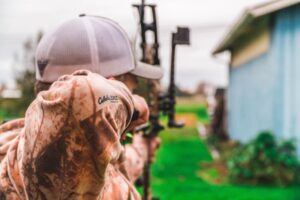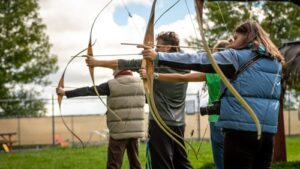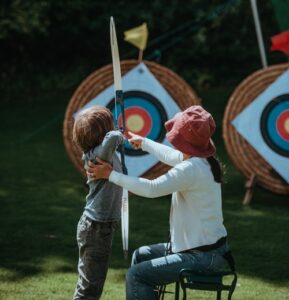Archery Safety Rules For Beginners.

Archery can be a very safe sport, whether target shooting, field archery, bowhunting or practicing 3D archery.
But there are a few guidelines and archery safety rules for beginners, to ensure it is safe for everyone around.
Have a proper archery target.
Use the correct target in a safe place.
A very fast compound bow, shooting small diameter arrows can penetrate and go through a target.
Particularly, if the target has been shot at a lot, and the target is chopped up and has little backing or substance.
Even with a lighter compound bow, recurve or longbow, some arrows will go through the target, especially, with cheap low quality targets.
Regardless of what your target is made of, whether it is compressed foam, straw, 3D animal target, DIY bag target made out of neoprene, or scrap pieces of cloth, it should stop the arrow going through the target.
As well as the target should be in good condition, do not place your target on top of a hill or mound, were you can’t see behind the target.
 Image above: Just a note on some of the above archers. Do not leave your finger close to the arrow when releasing the bow. Beginners new to archery normally have their bowstring hand grip on the bowstring too tightly and with too much fingers on the string. This then causes the arrow to swing off the arrow rest sideways. Hence that’s why they put their finger there to guide the arrow. But it can be dangerous for your finger.
Image above: Just a note on some of the above archers. Do not leave your finger close to the arrow when releasing the bow. Beginners new to archery normally have their bowstring hand grip on the bowstring too tightly and with too much fingers on the string. This then causes the arrow to swing off the arrow rest sideways. Hence that’s why they put their finger there to guide the arrow. But it can be dangerous for your finger.
Have a safe secondary backstop.
A missed shot and the arrow can travel for hundreds of feet. Or the arrow can deflect at an angle if it hits something, so ensure it is safe where you practice
Behind your main target, you should have a larger secondary barrier to stop the arrow, in case you miss the main target.
This could be a large wall safely back, or another bigger backstop to catch the arrow.
Always make sure that the back stop is sufficient to stop a stray arrow. Be aware of your surroundings and make certain that no other persons, or animals are between you and the target area or behind.
If you don’t have a secondary backstop, the area behind the primary target should be a clear wide space. With nothing behind it, or property that could be hurt or damaged.
If you use a large area, like some empty paddocks, ovals or woodlands, you should have a clear view to make sure it is safe.
Inspect the arrow.
Always inspect the arrow after each shot.
Arrows may be damaged through impact with other arrows or objects such as trees, rocks and improper targets, etc.
Never shoot an arrow that is cracked, splintered or damaged in anyway. For carbon arrows always flex and inspect the arrow.
One neglected part of the arrow that doesn’t get checked enough, is the arrow nock. Make sure it isn’t cracked, especially if you are getting good groups and your arrows are close enough to hit.
Match your arrows to your bow.
Ensure the arrow is spined correctly for your bow poundage, draw length and equipment set up. A weakly spined arrow could bend too much and split, or shatter if under spined.
Avoid the cheap arrows.
Some very low quality arrows that are unbranded can be dangerous when shot out of a compound bow. (Or any bow for that matter.)
Most of these arrows don’t have a spine listed on them, to state what poundage bow they are suited for. Even if they do have a spine listing, the quality is poor and they could be dangerous.
Stick with well-known brand arrows, such as Easton Archery, Gold Tip Arrows, Beman Arrows, Carbon Express Arrows, Victory Arrows, etc.
These reliable companies will have an arrow chart that you can easily match your bows draw weight, draw length with the correct spined arrows for your bow.
Don’t shoot at a high angle in the air.
Never shoot the arrow at a step angle high in the air, or straight up in the air. An arrow can go for a very long way and is extremely dangerous. Even out of a low poundage children’s bow, the arrow is dangerous.
Archery safety rules for beginners, check your archery equipment.
Before you even nock an arrow, inspect your bow is safe.
Check to see the limbs aren’t cracked and the cables, cams are all in good condition.
(I have had friends that their compound bow must have got bumped and the cam bent a little bit. When they went to draw the bow back, the cables come off the cams.)
Check your bowstring is in good order and isn’t frayed. Maintain it with bowstring wax and look after it. For information on when you should change your bowstring, click on Bowstrings for more information.
Double check your d loop is secure and visit How to tie a d loop to make sure it is correctly tied.
Check your regulations and rules.
Check with your local and state regulations and laws, about where you can and can’t shoot the bow and arrow. In some states in may be illegal to fire the bow and arrow in built up areas.
Adjusting the compound bow’s draw weight.
If you do lighten the poundage on a compound bow, don’t go past the manufacturers’ recommended amount of turns out with the Allen key / Hex wrench. As the limb bolts may come undone.
Obviously the bows limbs and cables are under a lot of pressure and undoing the limb bolts all the way is dangerous.
Stringing the bow safely.
When stringing and unstringing recurve bows and longbows, use a proper bow stringer.
I have heard of a lot of people getting hurt from trying to string the bow.
Some ways of stringing a bow are very dangerous. If you use an unsafe method and your face is near the bow, your hand can slip and the limb tip can hit you in the face or eye.
Use a proper bow stringer. This is safer for you, easier and will protect your bow.
A lot of methods for stringing the bow, without using a commercial bow stringer, such as step through method; you can twist the bow limbs and damage the bows.
Broadhead arrow safety.
Do not use broadheads on targets unless they are designed for them. Such as the Rinehart 18 -1 broadhead target or Yellow Jacket broadhead bag. Otherwise the broadheads will chop up your target quickly and eventually go through it.
If the target is designed for broadheads, be careful when pulling the arrows out of it.
If you are used to pulling arrows out with field points, or target points, you might have a tendency to pull the arrow with hand and place the other hand on the target to stop the target from moving. When you place your hand on the target, some people put there thumb one side of the arrow and their fingers the other side. The arrow being pulled out is close to the webbing and fingers. Some broadheads can be sharp on the back end of the blades and cut you if the hand is too close to the arrow when pulling it out of the target.
When a broadhead is not being used, put it in the bow quiver and makes sure it is secure. Or unscrew them and put the broadhead in a safe plastic container.
Archery safety for children.

For minors always shoot with adult supervision. Children’s archery can be fun, but the child should be supervised safely.
Make sure the arrows are properly matched to their bow.
Also with young children shooting the bows, they have a tendency to pull the bowstring and draw the bow back past there ear. So make sure the arrows are long enough and don’t fall of the arrow rest if pulled back too far.
Armguards and tabs, or shooting gloves can stop the bowstring from hitting the arm and help protect the fingers. Which can be painful for young kids. (And adults.)
Conclusion. – Archery safety rules for beginners.
Always obey the club and archery safety rules for beginners. Follow the safety rules and laws covering the use and ownership of archery products in your state.
Remember that a bow and arrow can be dangerous, so always think safety first.
Enjoy your archery, but be safe.
